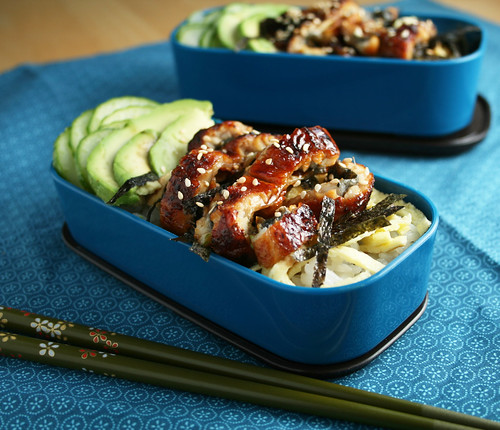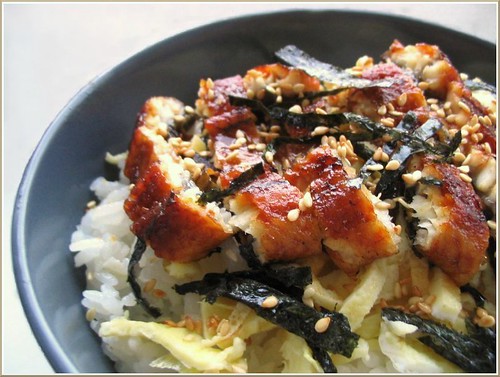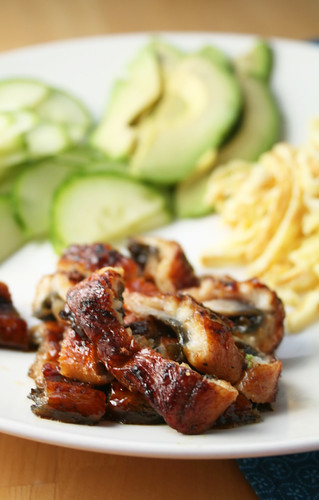
I bought some adorable bento boxes over Christmas break.
When Steven and I go out to sushi, we always have to get something with unagi. Steven usually goes for the unagi rice bowl, unagi fillet over a bed of steamy rice served in a handsome, black lacquered box – simple, refined, and elegant. Whereas I love the truly ostentatious, completely over-the-top rolls with unagi, avocado, deep fried soft shell crab, you name it, preferably with some sort of vegetable antenna sticking out.
As a compromise, with these sushi bowls aka lazy sushi, Steven gets his unagi on rice and I get to add a bunch of extras to jazz things up. It has to have avocado because I heart avocado and the textural contrast between the creamy avocado, soft unagi, and crunchy cucumber, and crisp nori is amazing. It’s perfect for when we get a sushi craving but I’m too lazy to stand there rolling sushi, especially when my rolling skills leave much to be desired.

Wow look at this ooolllddddd picture from June 07. Hopefully my photography has improved since then.
If you live close to an Asian grocery store, like 99 Ranch, you can find unagi precooked and vacuumed sealed in the frozen section. You can microwave, bake, or boil the unagi directly in the bag to heat it up. A 7 oz. fillet will usually make around 3 servings. If you don't have eel, you can use crab or shrimp.

Unagi Sushi Rice Bowl
7 oz. unagi fillet cooked according to package instructions
1 large egg, beaten
Cucumber slices
Avocado slices
Nori, cut into thin slivers (I used kitchen shears)
2 tsp toasted white sesame seeds
Kabayaki Sauce (recipe follows)
Sushi Rice (recipe follows)
Usually unagi is fully cooked so you just need to warm it up in the oven. Prepare it to package instructions, mine said to bake it in a 400ºF oven for about 10 minutes.
Beat the egg with a pinch of salt. Heat about a teaspoon of oil in a large nonstick skillet over medium heat. Pour in the beaten egg and swirl the pan to cover the pan evenly with a thin sheet of egg. When the egg looks almost set, shake the thin egg sheet onto a large plate then flip the egg into the skillet again to cook the second side. The entire process will take about 2 minutes because the egg will cook really quickly. Julienne the egg into thin strips.
Add a portion of sushi rice in a bowl then top with egg strips, cucumber slices, avocado slices, nori slivers, and unagi. Drizzle with kabayaki sauce to taste and sprinkle with sesame seeds.
Unagi Kabayaki Sauce
1/4 C soy sauce
1/4 C mirin
1 Tbsp white sugar
Add the mixture to a small saucepan and simmer gently until slightly thickened, be careful to not burn the soy sauce.
Sushi Rice
2 C short grain or sushi rice
2 C water
1/4 C rice vinegar
2 Tbsp sugar
1/2 tsp salt
I usually cook rice in the rice cooker so I honestly have no idea how to cook it on the stovetop.
Dissolve the vinegar, sugar, and salt either in a saucepan over low heat or microwave for 30 seconds until the solution is warm and whisk to dissolve.
When the rice is finished cooking, pour the vinegar mixture over the rice and use a rice paddle or spatula to gently fold the rice. Don’t smash the rice. Let the rice cool until it is body temperature.


